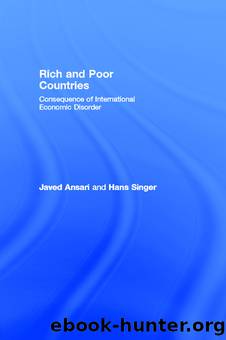Rich and Poor Countries by Ansari Javed;Singer Hans;

Author:Ansari, Javed;Singer, Hans;
Language: eng
Format: epub
ISBN: 169133
Publisher: Taylor & Francis Group
PART III
International Finance
7 Aid and Development
Aid, Trade and the Widening Gap
A central aspect of international development that we ought perpetually to keep in mind is the fact that it can safely be predicted that the gap between the richer and poorer countries is bound to grow in both absolute and relative terms in the foreseeable future. The specialists may quibble about the exact magnitude of the different variables and their growth rates, but intellectual sophistry of this sort cannot conceal the hard fact that the average Bangladeshi or Tanzanian will in the year 2000 have a much lower standard of living in comparison to the standard of living enjoyed by the average British, American or USSR citizen.
In the course of the next thirty years the gap between the rich and poor countries may widen by between three and four times, and the consequences both political and economic of this colossal growth in inequality are likely to be immense. Indeed, it goes without saying that the stability of the world order as we know it depends crucially on the way in which this problem of the ever-widening gap between nations is handled by the international community. Two-thirds of the worldâs population will not reconcile itself to a level of living that is permanently diminishing in comparison to the standards enjoyed by the privileged citizens of Northern America, Europe and the oil-rich countries. A crisis in international relations is almost inevitable if the rich countries complacently accept their lead and advantages as a fact of life. If the international economic system is incapable of providing the wherewithal for an effective reduction of inequality within the community of nations, the LDCs will feel justified in their attempts to destroy the political and economic system that perpetuates international inequalities.
A realization of the seriousness of this problem was fundamental to the first Brandt Report.1 Published in March 1980, the report recommended a âmassive transfer of resourcesâ as one of the main instruments (but by no means the only instrument) for reducing the inequalities of income distribution between rich and poor countries, and for releasing at the same time the world economy, including especially the rich countries, from the deadlock of world depression and âstagflationâ. Within this massive transfer of resources, in turn, the increase and improvement of aid or official development assistance (ODA) was to play a key role. In this, the Brandt Commission echoed some of the proposals made over a decade earlier (1969) by its predecessor, the Commission on International Development, headed by the former Canadian Prime Minister, Lester B.Pearson. The Pearson Report at the time failed to have an impact, because shortly after its publication the Bretton Woods system began to come apart, the industrial countries became preoccupied with their own troubles, and a little later the oil crisis of 1973 changed the context of international discussion.
Regarding the quantity of ODA, the Brandt Commission once again recommended an early achievement of the old UN target of 0.7 per cent of GNP of richer countries.
Download
This site does not store any files on its server. We only index and link to content provided by other sites. Please contact the content providers to delete copyright contents if any and email us, we'll remove relevant links or contents immediately.
International Integration of the Brazilian Economy by Elias C. Grivoyannis(74744)
The Radium Girls by Kate Moore(11621)
Turbulence by E. J. Noyes(7700)
Nudge - Improving Decisions about Health, Wealth, and Happiness by Thaler Sunstein(7242)
The Black Swan by Nassim Nicholas Taleb(6763)
Rich Dad Poor Dad by Robert T. Kiyosaki(6174)
Pioneering Portfolio Management by David F. Swensen(6078)
Man-made Catastrophes and Risk Information Concealment by Dmitry Chernov & Didier Sornette(5646)
Zero to One by Peter Thiel(5488)
Secrecy World by Jake Bernstein(4388)
Millionaire: The Philanderer, Gambler, and Duelist Who Invented Modern Finance by Janet Gleeson(4094)
The Age of Surveillance Capitalism by Shoshana Zuboff(3983)
Skin in the Game by Nassim Nicholas Taleb(3965)
The Money Culture by Michael Lewis(3846)
Bullshit Jobs by David Graeber(3830)
Skin in the Game: Hidden Asymmetries in Daily Life by Nassim Nicholas Taleb(3722)
The Dhandho Investor by Mohnish Pabrai(3560)
The Wisdom of Finance by Mihir Desai(3523)
Blockchain Basics by Daniel Drescher(3329)
